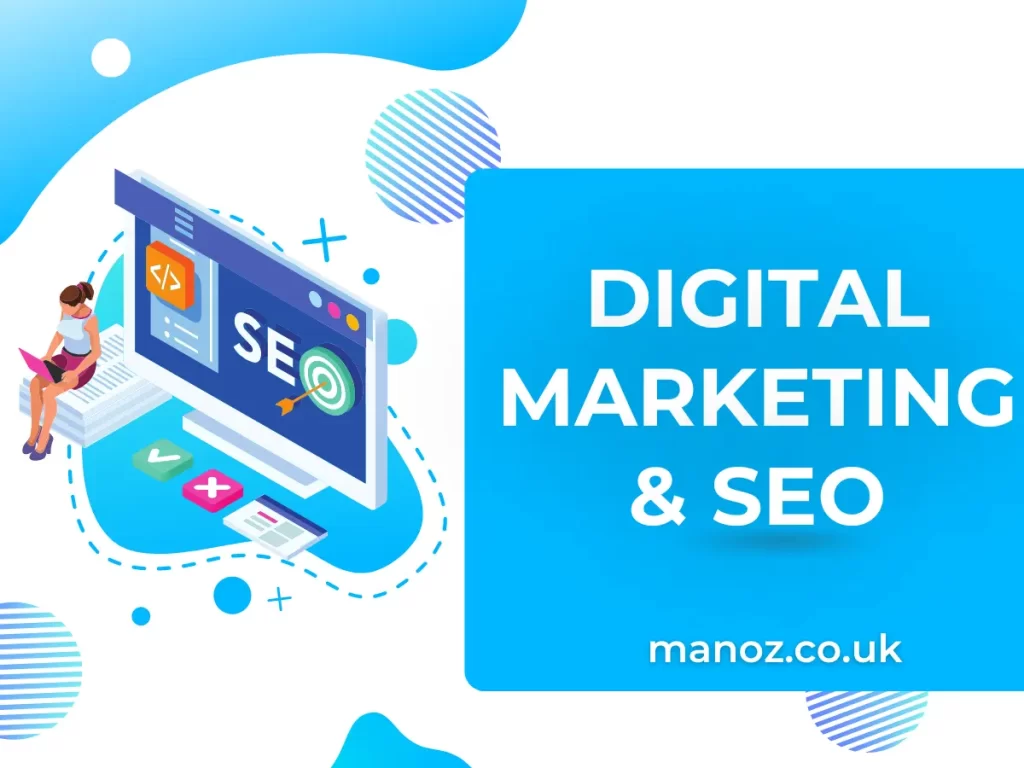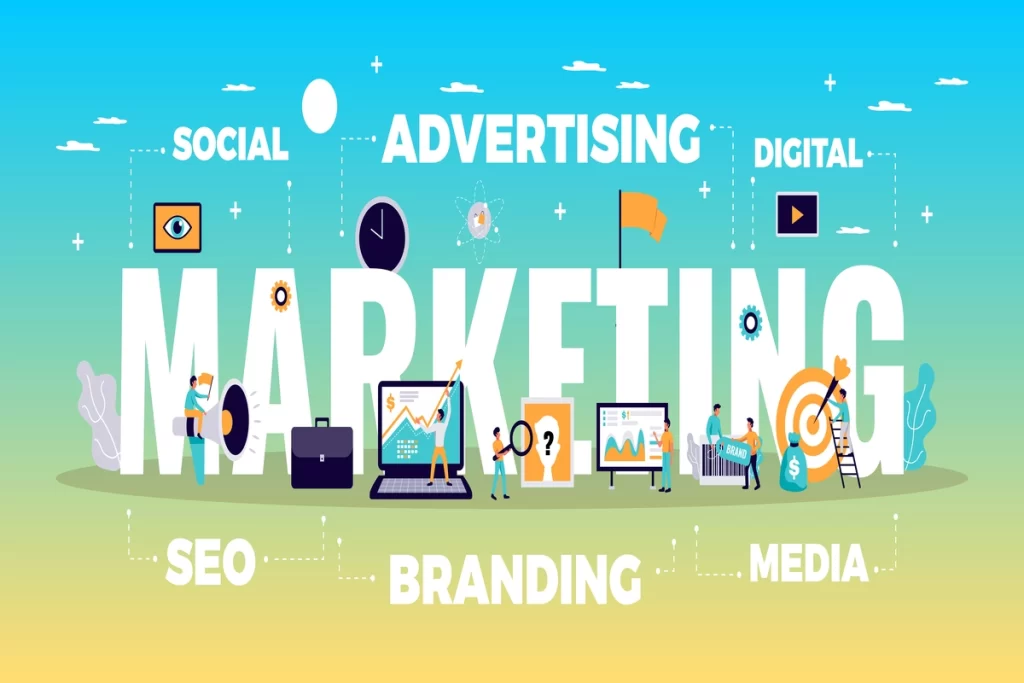Digital marketing and SEO improve a website’s ranking in search results for specified queries.
(SEO)- a strategy that increases the visibility and ranking of any content or website. And web pages that appear on the top results (SERPs).
Making the website appealing and relevant to search engine algorithms takes time. But you can boost your online visibility and get traffic by doing proper SEO and marketing strategies.
SEO in Digital Marketing
Digital marketing relies heavily on SEO. These two are the most important elements of any successful marketing strategy.
You can reach a wider audience. Drive more traffic to boost your website’s ranking.
With the rapid growth of the internet and SEO trends. All this is necessary to remain competitive.
Here, we will summarise the importance of SEO in digital marketing and how it will help your business succeed.
What is SEO?
SEO (Search Engine Optimization), an activity to increase organic search traffic to a website, also builds brand recognition. Keyword exploring, content making, link building, and technical audits are all involved in SEO.
What is Digital Marketing?
Online marketing to increase a brand’s visibility digital marketing. Through this, you could meet with potential customers. Let’s come and dive into digital marketing and SEO.
SEO Involves What Type of Marketing?
SEO is one method of increasing a website’s visibility to appear near the top of Google’s search results. In digital marketing, SEO is of the utmost importance in all digital marketing strategies.
So, all marketing involves SEO.
Many online consumers select from the first 10 results. Relatively that appears on the first page of the website for a service or product.
Google Top 10 Results
Google prefers to list some sites on the first page. Because of their optimization. The pages that are most relevant, accurate, and authentic for the topic or keyword they write for. Websites apply SEO techniques and optimize their content for specific keywords.
Optimizing the site or on-page SEO can help you get more traffic until you do digital marketing. Using many tactics and strategies to boost your search rankings to six figures.
Here we mention types of SEO. That will rank your and your client’s websites better in search engine results.
On-Page SEO
On-page SEO refers to optimizing individual web pages to improve SEO for search engine rankings. Will drive organic traffic to the site. On-page SEO includes optimizing the content on the page.
Also, the HTML source code and the website architecture. The following are some key elements of on-page SEO:
Researching keywords and Phrases:
Users search keywords and phrases for relevant information in the web page’s content.
Meta-Descriptions:
Writing compelling and relevant meta-descriptions encourages users to click through to the web page.
Title Tags:
Create descriptive and keyword-rich titles for each web page that accurately reflect the page’s content.
Headers and subheaders:
Use headings and subheadings to structure the page’s content and make it easier to read.
Image Optimization:
Using descriptive file names and alt tags to optimize images on the page
Internal Linking:
lt Linking to other pages within the website to improve navigation and promote other relevant content.
Off-Page SEO
Off-page SEO refers to optimizing factors outside of the website that can impact its search engine rankings. These factors include backlinks, social media engagement, and other external signals that state the relevance and authority of the website. Off-page SEO key elements include:
Backlinks: building high-quality, relevant links from other websites to improve the website’s authority and credibility
Social media engagement: using social media platforms to promote the website and engage with users
Brand mentions are monitored and tracked on other websites and social media platforms.
Guest blogging means contributing to other websites’ blogs to build backlinks and promote the website.
Technical SEO
It involves optimizing a website’s technical aspects, which can impact its rankings. It includes optimizing the website’s code, structure, and functionality to ensure it is easily crawled and indexed by search engines. Technical SEO key elements include:
Site speed: Optimizing the website’s loading speed to improve user experience and search engine rankings
Mobile responsiveness: ensuring the website is mobile-friendly and optimized for mobile devices
Site architecture: organizing the website’s pages and content in a logical and structured way to make it easy for search engines to crawl and index.
XML sitemap: creating and submitting an XML sitemap to search engines to help them understand the website’s structure and content
URL structure: using descriptive and keyword-rich URLs that accurately reflect the page’s content
International SEO
International SEO optimizes a website’s ranking in search engines across different countries and languages. This type of SEO involves various strategies, such as creating culturally relevant content and targeting specific keywords in different languages.
International SEO also includes strategies for increasing a website’s visibility in local search engines like Baidu in China and Yandex in Russia.
Businesses can increase their reach and attract new customers worldwide by optimizing their websites for international audiences.
Local SEO
In local SEO, a website is optimized to rank in local search results. It includes optimizing for location-based keywords.
such as “restaurants near me,” “digital marketing agency in the UK,” and creating local business listings on platforms like Google My Business. Local SEO is especially important for businesses with a physical location or serving customers in a specific geographic area.
Businesses can attract more foot traffic to their physical location and increase online visibility in their local community.
E-commerce SEO
SEO for an e-commerce site is optimizing the online store for ranking in search engine results. It includes optimizing product descriptions, images, and URLs to be keyword-rich and user-friendly.
E-commerce SEO also involves optimizing for the user experience, such as ensuring fast page loading speeds and making the checkout process as simple and seamless as possible.
By optimizing an e-commerce website for SEO, businesses can attract more qualified traffic to their store, improve their online visibility, and increase their revenue.
Content SEO
Optimizing the content to rank higher in search engines is “content SEO.” It includes creating high-quality, engaging content optimized for specific keywords and topics.
Content SEO also involves optimizing website structure, such as creating a logical hierarchy of pages and using internal links to guide users through the website.
By optimizing website content for SEO, you can attract more valuable traffic, establish yourself as thought leader in your industry, and increase your online visibility.
Mobile SEO
Mobile SEO is optimizing a website to rank higher in mobile search results. It includes optimizing for mobile-specific search queries. Such as voice search and ensuring the website is mobile-friendly and optimized for smaller screens.
Mobile SEO also involves optimizing for the mobile user experience, such as ensuring fast page loading speeds and using responsive design to adapt to different devices.
By optimizing for mobile search, businesses can attract more mobile users to their websites, improve their online visibility, and increase their revenue.
YouTube SEO
Among the world’s largest search engines, YouTube is the second most popular with more than 2 billion active monthly users.
It is a powerful platform for digital businesses looking to increase online visibility and reach potential and new audiences.
It is where YouTube SEO comes in.
YouTube SEO is optimizing videos to rank higher in search results and recommendations. It includes optimizing video titles, descriptions, and tags with relevant keywords, creating high-quality and engaging content, and promoting videos through social media and other channels.
By optimizing for YouTube SEO, businesses can attract more views, and increase engagement.
Final Thoughts On Digital Marketing and SEO
A successful digital marketing strategy requires search engine optimization (SEO). Businesses can create a targeted approach to their specific goals and audiences by understanding the different types of SEO and marketing tactics.
International SEO, local SEO, e-commerce SEO, content SEO, and mobile SEO have unique benefits and challenges.
Still, by incorporating these strategies into a comprehensive SEO plan, businesses can drive more traffic to their website. They increase their online visibility and ultimately boost their revenue.
Social media marketing in SEO Digital Marketing
Social media marketing falls under the category of digital marketing. It is vital in SEO. As social media platforms have become integral to people’s daily lives.
Social media marketing involves using social media platforms. Like Facebook, Twitter, Instagram, LinkedIn, and others to promote products or services. The easiest way to engage with customers and build brand awareness.
It includes creating and sharing engaging content, running targeted advertising campaigns, and utilizing social media analytics to track performance and adjust strategies according to it.
Social media marketing reaches a broad audience. And to target specific demographics depending on the business’s goals.
By leveraging social media marketing, businesses can increase their online visibility. They build brand awareness and engage with their target audience. Driving more traffic to their website and increasing their revenue.


